|
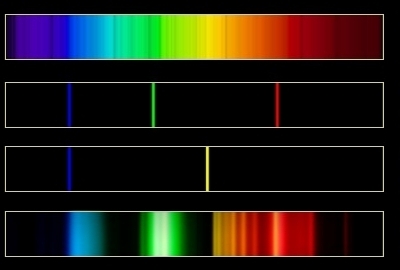 Since the human visual system extrapolates colors from what it detects at just three basic wavelengths, it is easily fooled. Here we have the spectra of four different light sources. At the top, sunlight. Second, just emission of light at blue, green, and red wavelengths. Third, just emission at blue and yellow wavelengths. Fourth, the emission of a fluorescent lamp. To the human eye, the light from each of these sources appears the same: white! (If you are reading this on a computer screen, chances are that the spectrum coming off that screen looks very much like the red-green-blue emission lines of the second spectrum-- all you're getting off a white image on your screen is discrete red, green, and blue light; it takes the human visual system to interpret that as "white".) Since the human visual system extrapolates colors from what it detects at just three basic wavelengths, it is easily fooled. Here we have the spectra of four different light sources. At the top, sunlight. Second, just emission of light at blue, green, and red wavelengths. Third, just emission at blue and yellow wavelengths. Fourth, the emission of a fluorescent lamp. To the human eye, the light from each of these sources appears the same: white! (If you are reading this on a computer screen, chances are that the spectrum coming off that screen looks very much like the red-green-blue emission lines of the second spectrum-- all you're getting off a white image on your screen is discrete red, green, and blue light; it takes the human visual system to interpret that as "white".)
Hence, the human eye is not a good tool for judging the detailed spectral characteristics of a light source. This especially comes into play when trying to use the Correlated Color Temperature (CCT) to judge the complex effects (visual, ecological, etc.) of complex spectra. CCT is entirely based on human perception, characterizing a complex spectrum (such as metal halide or fluorescent) as a smooth-spectrum incandescent (blackbody)3 with the same perceived color balance. A spectral energy distribution (often termed Spectral Power Distribution, or SPD) analysis is needed (rather than CCT) to see "inside" the light coming from many artificial sources, when studying the effects which different wavelengths of light have on vision and the environment.
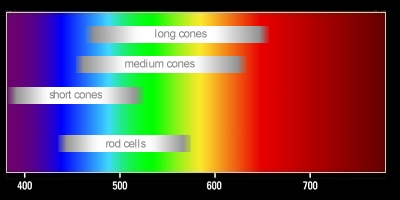 HUMAN VISION IN LOW LIGHT: HUMAN VISION IN LOW LIGHT:
In low light levels, the sensitivity of the retinal cone cells tapers off, and the rod cells take over. There is only one type of rod cell, so the vision it provides is monochromatic; by moonlight, we see only in "black and white". This chart shows the spectral sensitivity range of each of the cone cells which together provide "photopic" (daytime) vision, and the more sensitive rod cells which provide our "scotopic" (nighttime) vision4. In moderate light levels, such as at dusk outdoors or under many artificial light conditions, both the rod and the cone cells contribute to human visual perception. The spectral response of the human visual system under such circumstances is complex and only partly understood. In general, though, this "mesopic" (twilight) vision has a spectral sensitivity peak intermediate between that of photopic and scotopic vision, the shape of this response is affected very strongly by not only the amount of light available, but also by the visual task -- what it is you're seeing and reacting to. As an example, at a given lighting level, the effect of the light source spectral distribution on the ability to read a sign is likely to be much different than the effect on your ability to detect a deer at the side of the road. Much more research is needed to increase our understanding of vision at the intermediate lighting levels relevant to outdoor lighting.
LIGHT COLOR AND VISUAL PERCEPTION:
The human eye, in daylight (photopic) conditions, achieves its peak sensitivity in the yellow-green range, at around 555 nanometers wavelength (with all three cone cell types working together). Peak scotopic sensitivity (nighttime vision) is around 510 nm, in the blue-green; the mesopic peak floats somewhere between the day and night peaks (in the greens), depending on the lighting level, the portion of the eye's field of view involved, and the visual task. It makes sense to consider these peaks when providing artificial light, so we can provide the best visual acuity while using the least energy to produce light. But, there is more to color and visual perception than light sensitivity alone.
 Research shows that the amount of perceived discomfort glare from a light source, especially at night, is strongly dependant on the color composition of the light. In the graph on to the left, the black lines show the level of reported discomfort experienced by observers viewing light sources of the same intensity, but at different wavelengths5. The line with the solid dots is the data from younger research subjects (in their 20s); the line with the open circles represent older subjects (in their 60s and 70s). We see a significant increase in perception of glare with a change in light color, especially toward the blue end of the spectrum. Research shows that the amount of perceived discomfort glare from a light source, especially at night, is strongly dependant on the color composition of the light. In the graph on to the left, the black lines show the level of reported discomfort experienced by observers viewing light sources of the same intensity, but at different wavelengths5. The line with the solid dots is the data from younger research subjects (in their 20s); the line with the open circles represent older subjects (in their 60s and 70s). We see a significant increase in perception of glare with a change in light color, especially toward the blue end of the spectrum.
Other research indicates that a prime source for the perception of glare comes from the short-wavelength responding cone cells; in this research, the highest ratings for discomfort coincide directly with the sensitivity curve for those cells6. We have added that color response curve to the same graph, borrowing it from the human vision in daylight chart, above. This color-related aspect of glare has been witnessed by anyone who has been annoyed by the oncoming headlights of vehicles equipped with the new blue-rich high-intensity discharge lamps.
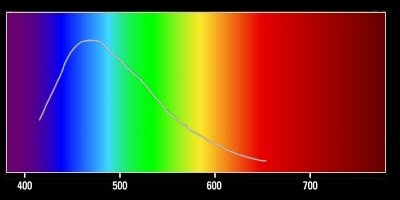 The lens of the eye actually fluoresces -- glows -- when exposed to light. This graph shows how the amount of fluorescence is directly related to the wavelength of light entering the eye7. This effect becomes more pronounced as the eye ages8, and can affect visual acuity in both high and low light levels. It likely adds to the perception of glare at night, making those blue-tinted headlights even more disruptive for older drivers than younger ones. The lens of the eye actually fluoresces -- glows -- when exposed to light. This graph shows how the amount of fluorescence is directly related to the wavelength of light entering the eye7. This effect becomes more pronounced as the eye ages8, and can affect visual acuity in both high and low light levels. It likely adds to the perception of glare at night, making those blue-tinted headlights even more disruptive for older drivers than younger ones.
The dilation and constriction of the iris has been shown to be regulated primarily by exposure to blue light; the photopigment melanopsin (see below) is thought to play a key role. In lower light conditions, we need the pupils of our eyes open as widely as possible for the highest visual sensitivity, but the use of artificially blue-heavy light, even at lower intensities, may cause undesirable pupillary constriction.
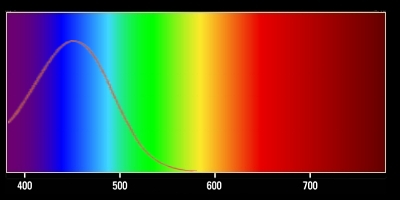 LIGHT COLOR AND HEALTH: LIGHT COLOR AND HEALTH:
It has been well established that the circadian rhythm in our bodies plays a critical role in maintaining our health9. Disrupting this internal clock leads to increased occurrence of a long list of physiological ills, from disrupted sleep, to depression, to obesity and even some forms of cancer. It has also been shown that the light/dark cycle of day and night sets our internal clock, and that exposure to light during what should be the dark period of night keeps the circadian systems within the body from being correctly synchronized.
The light detector for this clock-setting function is a material called melanopsin; it is located in non-visual cells (not the rods or cones) in the retina of the eye. Melanopsin is triggered by short wavelength visible light; this chart shows the curve of wavelengths which have been effective in reducing the production of melatonin (a product of a healthy circadian rhythm) in humans10.
Photons of shorter wavelengths carry more energy. Because of this, blue and ultraviolet light to create much more "wear and tear" damage to the cells in the retina of the eye than moderate or long wavelengths, leading to vision loss11. Children's eyes are particularly susceptible to the phototoxic effects of shortwave light.
OTHER ISSUES WITH LIGHT COLOR:
We are only beginning to research the effects which both natural and manmade light have on the natural world. Some things may seem obvious, such as that green plants need light, and some animals are diurnal and others nocturnal, but the roles which light and the day/night and seasonal cycles play in the lives of many organisms are poorly understood. It is obvious, from what research has been done, that light isn't just light in any part of biology; spectral quality plays a key role in every system studied so far.
Since its discovery just over a decade ago, melanopsin has been found in numerous organisms; it seems to be a very ancient light sensing compound, and may well play a role in the regulation of circadian rhythms of many other living things, even as simple as algae. All such organisms will tend, therefore, to have their melanopsin-related photodetection disrupted more (if not only) by blue light. Visually perceived light also greatly affects other organisms; for instance, many insects are drawn out of their ecosystem niches to die instead around outdoor lights, while many bat species are in population declines around populated areas, and have been shown to avoid artificial light. In some beach areas in Florida, new lighting has been installed to reverse the problem which earlier lighting created, of causing sea turtle hatchlings to head inland rather than down to the ocean. But new, more yellow-balanced lights, which are less disruptive to the turtles, turned out to be more disruptive to the native, nocturnal beach mice12.
SKYGLOW:
The "light pollution" which lights up the sky throughout the night over most populated areas today is very spectrally dependant. The daytime sky is blue entirely because as sunlight shines through our atmosphere, most of the colors of its "rainbow" pass on through, but some of the blue wavelengths are scattered by molecules in the air. The same effect occurs at night; the redder wavelengths of light shining up from artificial sources on the ground tend to pass on out into space, while the bluer wavelengths are more prone to scattering, and shining back down into our eyes, making the sky gray rather than black.
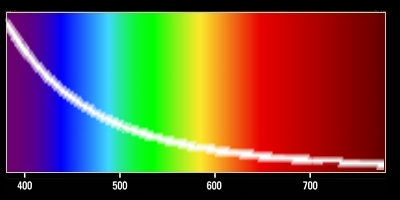 We can see the spectral bias of this scattering in Earth's atmosphere in this graph to the left; very little scattering occurs on the red end of the spectrum, but the rate is high on the blue end. When the air is hazy with dust or smog, the strength of this effect is decreased, but not eliminated. In addition, the visibility of sky glow from blue-rich light sources on the ground is dramatically increased because this blue light, preferentially scattered in the atmosphere, is also the light that the eye is most sensitive to when it is adapted to dark conditions (as discussed above). We can see the spectral bias of this scattering in Earth's atmosphere in this graph to the left; very little scattering occurs on the red end of the spectrum, but the rate is high on the blue end. When the air is hazy with dust or smog, the strength of this effect is decreased, but not eliminated. In addition, the visibility of sky glow from blue-rich light sources on the ground is dramatically increased because this blue light, preferentially scattered in the atmosphere, is also the light that the eye is most sensitive to when it is adapted to dark conditions (as discussed above).
WHITE LEDs IN PARTICULAR:
Spectral issues are of key concern with any artificial light source. But light-emitting diodes (LEDs) deserve a focused look, partly because of how they create light, but also because of the increased role which they are expected to play in the future of both indoor and outdoor lighting. As far as technology is concerned, they are also still in an early stage; many developments and improvements are expected over the next decades, and a focus on the effects of the spectral quality of their light should play a large part in leading that developmental effort.
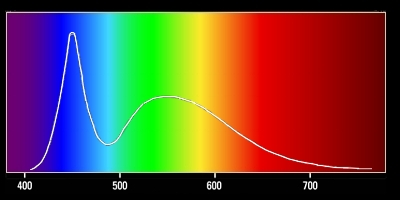 Most of the high brightness "white" LEDs currently in development are actually blue LEDs, with a peak emission at about 460 nm. A phosphor compound is placed on top of the emitter; this compound absorbs some of the blue light, and re-emits it at longer wavelengths, usually peaking in the yellow range. Most of the high brightness "white" LEDs currently in development are actually blue LEDs, with a peak emission at about 460 nm. A phosphor compound is placed on top of the emitter; this compound absorbs some of the blue light, and re-emits it at longer wavelengths, usually peaking in the yellow range.
The first spectral power distribution graph (top left) is of a white LED with a correlated color temperature (CCT) of 6650°K; the amount of the original blue light passing out through the phosphor coating is high13. The light from this LED has a strong blue "cold" cast; many would perceive it as "harsh".
|
|
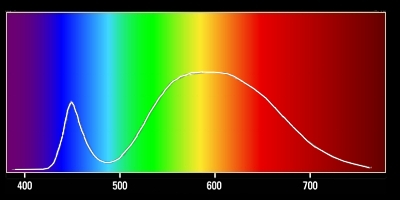 The lower SPD graph is of a white LED with a CCT of 2875°K; a "warm white" appearance, more like an incandescent lamp. A heavier coating of phosphors has been applied to this LED, absorbing more of the original blue output, and emitting a higher percentage of light from the yellow phosphors than directly from the LED. This "Stokes shift" of light from the blue to the longer wavelengths is not perfectly efficient; some energy is lost in the process. So, the bluer LED has a somewhat higher energy efficiency, although this technology is steadily improving. And because of how these LEDs work, even though the "warmer" appearing one has notably less blue output than the 6650°K one, it puts out far more deep blue light than an actual 2875°K incandescent lamp would (repeating our earlier warning that CCT is not an accurate way of analyzing spectral output). The lower SPD graph is of a white LED with a CCT of 2875°K; a "warm white" appearance, more like an incandescent lamp. A heavier coating of phosphors has been applied to this LED, absorbing more of the original blue output, and emitting a higher percentage of light from the yellow phosphors than directly from the LED. This "Stokes shift" of light from the blue to the longer wavelengths is not perfectly efficient; some energy is lost in the process. So, the bluer LED has a somewhat higher energy efficiency, although this technology is steadily improving. And because of how these LEDs work, even though the "warmer" appearing one has notably less blue output than the 6650°K one, it puts out far more deep blue light than an actual 2875°K incandescent lamp would (repeating our earlier warning that CCT is not an accurate way of analyzing spectral output).
SUMMARY:
- The colors of light created by our artificial light sources play a large part in determining both the quality of illumination they provide, and the levels of undesirable environmental impacts which they create.
- Much more research needs to be done to investigate and quantify how different wavelengths of light interact with our environment, but we do already have a substantial amount of data. It seems clear that many negative, unintended effects are notably increased in shorter, bluer wavelengths of light.
CONCLUSION:
As a society, we need to become aware that "light isn't just light"; analysis of the spectral nature of the light which we create, and fill our nocturnal world with, is critically important. Both current lighting practice and future advances, including LED technology, need to be driven by work in spectral analysis. The lighting industry's focus up until now, on human perception issues of Correlated Color Temperature and Color Rendering Index, is not structured to deal with important spectral effects.
Light with wavelengths shorter than 500 nanometers seems clearly to pose problems in human visual perception and health, and in other areas, including skyglow. Health effects related to exposure to manmade light at night will probably turn out to be strongly influenced by indoor lighting, but it is a mistake to ignore our exposure from outdoor illumination, which pervades our nocturnal environments more each year.
In nearly all situations where artificial lighting is used outdoors, human vision is influenced by both rod and cone spectral sensitivities. Since both of these cell groups are most sensitive to light that is longer than 500 nm, we can optimize lighting color for vision at night but still reduce the amount of potentially disruptive light emitted below 500 nm. This, indeed, should be a major driving goal in the development of better light sources. And there will be instances where moderately high (photopic) illumination is needed, but we don't need precise color rendition; in those cases we'll probably be better off using light sources which have very little output in wavelengths shorter than our peak sensitivity in the yellow-green.
But longer wavelengths of light, even into the infrared, can also create environmental disruption when dumped into nocturnal environments. It is likely we will never know which wavelengths are most disruptive to each of the hundreds of thousands of species of organisms we share this planet with. The only prudent solution for minimizing the total negative effects our artificial lighting has on the environment is to re-think how we apply light at night, and adopt the practice of only applying the minimal levels needed, focused only on the areas where we have tasks to accomplish, only at the times we are active there. Only that practice can minimize all the unintended negative effects of manmade light at night. But where we do need to apply light, color matters.
1 Ceramic metal halide lamp spectral data adapted from Koninklijke Philips Electronics 2 Human cone cell response graph based on data from Rushton, Brown & Wald, from Adler's Physiology of the Eye, Clinical Application (1987), Moses & Hart, ed. 3 For more discussion of any technical terminology on this page, consult the Encyclopedia of Lighting Terminology page of this website 4 Photopic/scotopic response graph data from Principles of Vision (2005), Kalloniatis & Luu 5 Glare response data from Effect of Wavelength on Discomfort Glare From Monochromatic Sources (1989), Flannagan, Sivak, Ensing & Simmons 6 Discussion of the Short cone's role in discomfort glare from Yellow Lessens Discomfort Glare: Physiological Mechanism(s) (2004), Kooi & Alferdinck 7 Lens fluorescence graph data from In Situ Measurements of Lens Fluorescence and Its Interference With Visual Function (1992), Zuclich, Glickman & Menendez 8 See Human lenticular fluorescence and transmissivity, and their effects on vision (1985), Weale 9 See Circadian clocks: regulators of endocrine and metabolic rhythms (2007), Hastings, O’Neill & Maywood 10 Melatonin regulation spectral curve data from Action Spectrum for Melatonin Regulation in Humans (2001), Brainard, Hanifin, Greeson, Byrne, Glickman, Gerner & Rollag 11 For additional discussion of the phototoxic effects of blue light on human eye health, see The Effects of Blue Light on Ocular Health (2000), Kitchel 12 See Sea Turtle-Friendly Beach Lights Disturb Rare Mouse (2004), Society for Conservation Biology 13 White LED spectral power distribution data (both graphs) courtesy www.olino.org
|


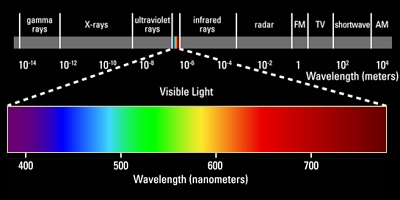 Light which is visible to our human eyes represents just a tiny percentage of the full spectrum of electromagnetic radiation-- just a few of the many wavelengths which photons of light come in. From the insects which see in ultraviolet wavelengths, to the reptiles which hunt in infrared, many organisms see the world in different light than we do. And, within our visible spectrum, light color effects vary greatly, too; one example being how stem elongation in plants is regulated by blue light, while flowering period is triggered by red-orange light.
Light which is visible to our human eyes represents just a tiny percentage of the full spectrum of electromagnetic radiation-- just a few of the many wavelengths which photons of light come in. From the insects which see in ultraviolet wavelengths, to the reptiles which hunt in infrared, many organisms see the world in different light than we do. And, within our visible spectrum, light color effects vary greatly, too; one example being how stem elongation in plants is regulated by blue light, while flowering period is triggered by red-orange light. INFORMATION FROM SPECTRA:
INFORMATION FROM SPECTRA: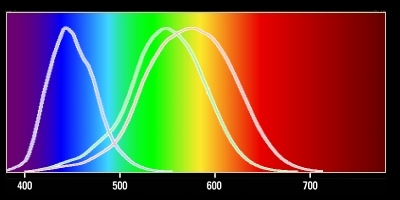 HUMAN VISION IN DAYLIGHT:
HUMAN VISION IN DAYLIGHT: Since the human visual system extrapolates colors from what it detects at just three basic wavelengths, it is easily fooled. Here we have the spectra of four different light sources. At the top, sunlight. Second, just emission of light at blue, green, and red wavelengths. Third, just emission at blue and yellow wavelengths. Fourth, the emission of a fluorescent lamp. To the human eye, the light from each of these sources appears the same: white! (If you are reading this on a computer screen, chances are that the spectrum coming off that screen looks very much like the red-green-blue emission lines of the second spectrum-- all you're getting off a white image on your screen is discrete red, green, and blue light; it takes the human visual system to interpret that as "white".)
Since the human visual system extrapolates colors from what it detects at just three basic wavelengths, it is easily fooled. Here we have the spectra of four different light sources. At the top, sunlight. Second, just emission of light at blue, green, and red wavelengths. Third, just emission at blue and yellow wavelengths. Fourth, the emission of a fluorescent lamp. To the human eye, the light from each of these sources appears the same: white! (If you are reading this on a computer screen, chances are that the spectrum coming off that screen looks very much like the red-green-blue emission lines of the second spectrum-- all you're getting off a white image on your screen is discrete red, green, and blue light; it takes the human visual system to interpret that as "white".) HUMAN VISION IN LOW LIGHT:
HUMAN VISION IN LOW LIGHT: Research shows that the amount of perceived discomfort glare from a light source, especially at night, is strongly dependant on the color composition of the light. In the graph on to the left, the black lines show the level of reported discomfort experienced by observers viewing light sources of the same intensity, but at different wavelengths5. The line with the solid dots is the data from younger research subjects (in their 20s); the line with the open circles represent older subjects (in their 60s and 70s). We see a significant increase in perception of glare with a change in light color, especially toward the blue end of the spectrum.
Research shows that the amount of perceived discomfort glare from a light source, especially at night, is strongly dependant on the color composition of the light. In the graph on to the left, the black lines show the level of reported discomfort experienced by observers viewing light sources of the same intensity, but at different wavelengths5. The line with the solid dots is the data from younger research subjects (in their 20s); the line with the open circles represent older subjects (in their 60s and 70s). We see a significant increase in perception of glare with a change in light color, especially toward the blue end of the spectrum. The lens of the eye actually fluoresces -- glows -- when exposed to light. This graph shows how the amount of fluorescence is directly related to the wavelength of light entering the eye7. This effect becomes more pronounced as the eye ages8, and can affect visual acuity in both high and low light levels. It likely adds to the perception of glare at night, making those blue-tinted headlights even more disruptive for older drivers than younger ones.
The lens of the eye actually fluoresces -- glows -- when exposed to light. This graph shows how the amount of fluorescence is directly related to the wavelength of light entering the eye7. This effect becomes more pronounced as the eye ages8, and can affect visual acuity in both high and low light levels. It likely adds to the perception of glare at night, making those blue-tinted headlights even more disruptive for older drivers than younger ones. LIGHT COLOR AND HEALTH:
LIGHT COLOR AND HEALTH: We can see the spectral bias of this scattering in Earth's atmosphere in this graph to the left; very little scattering occurs on the red end of the spectrum, but the rate is high on the blue end. When the air is hazy with dust or smog, the strength of this effect is decreased, but not eliminated. In addition, the visibility of sky glow from blue-rich light sources on the ground is dramatically increased because this blue light, preferentially scattered in the atmosphere, is also the light that the eye is most sensitive to when it is adapted to dark conditions (as discussed above).
We can see the spectral bias of this scattering in Earth's atmosphere in this graph to the left; very little scattering occurs on the red end of the spectrum, but the rate is high on the blue end. When the air is hazy with dust or smog, the strength of this effect is decreased, but not eliminated. In addition, the visibility of sky glow from blue-rich light sources on the ground is dramatically increased because this blue light, preferentially scattered in the atmosphere, is also the light that the eye is most sensitive to when it is adapted to dark conditions (as discussed above). Most of the high brightness "white" LEDs currently in development are actually blue LEDs, with a peak emission at about 460 nm. A phosphor compound is placed on top of the emitter; this compound absorbs some of the blue light, and re-emits it at longer wavelengths, usually peaking in the yellow range.
Most of the high brightness "white" LEDs currently in development are actually blue LEDs, with a peak emission at about 460 nm. A phosphor compound is placed on top of the emitter; this compound absorbs some of the blue light, and re-emits it at longer wavelengths, usually peaking in the yellow range. The lower SPD graph is of a white LED with a CCT of 2875°K; a "warm white" appearance, more like an incandescent lamp. A heavier coating of phosphors has been applied to this LED, absorbing more of the original blue output, and emitting a higher percentage of light from the yellow phosphors than directly from the LED. This "Stokes shift" of light from the blue to the longer wavelengths is not perfectly efficient; some energy is lost in the process. So, the bluer LED has a somewhat higher energy efficiency, although this technology is steadily improving. And because of how these LEDs work, even though the "warmer" appearing one has notably less blue output than the 6650°K one, it puts out far more deep blue light than an actual 2875°K incandescent lamp would (repeating our earlier warning that CCT is not an accurate way of analyzing spectral output).
The lower SPD graph is of a white LED with a CCT of 2875°K; a "warm white" appearance, more like an incandescent lamp. A heavier coating of phosphors has been applied to this LED, absorbing more of the original blue output, and emitting a higher percentage of light from the yellow phosphors than directly from the LED. This "Stokes shift" of light from the blue to the longer wavelengths is not perfectly efficient; some energy is lost in the process. So, the bluer LED has a somewhat higher energy efficiency, although this technology is steadily improving. And because of how these LEDs work, even though the "warmer" appearing one has notably less blue output than the 6650°K one, it puts out far more deep blue light than an actual 2875°K incandescent lamp would (repeating our earlier warning that CCT is not an accurate way of analyzing spectral output).